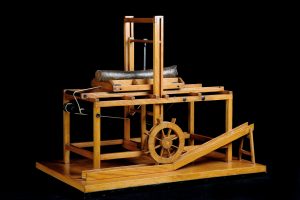A circular saw is a power-saw using a toothed or abrasive disc or blade to cut different materials using a rotary motion spinning around an arbor. It was invented in the 19th century.

Image source: https://search.creativecommons.org/photos/d5febe47-fc7b-4564-b314-73ae37b4ead2 by toolstop
A circular saw is a tool used to cut materials such as wood, masonry, plastic, or metal and can be held in the hand or mounted on a machine. The term “circular saw” in woodworking refers to the hand type while the table saw and the chop saw are other common forms of circular saws.
The invention of the circular saw
Samuel Miller is commonly said to have obtained British Patent #1152 in 1777 for what is considered the first circular saw. Some claim that the wording in his patent indicates that the circular blade itself was in common use at the time — it was the same saw that Miller had invented.

Image source: https://search.creativecommons.org/photos/5968eeb0-f545-4f1f-ba7b-9812c4e61c50 by BiblioArchives
The circular saw was a similarly and independently developed concept in some parts of the developing world. All these stories about the rise of the circular saw in Europe seem completely separate from its appearance in America. In the U.S. — more precisely in Harvard, Massachusetts — a Shaker woman named Tabitha Babbitt is said to have invented a circular saw entirely of her own will and design in 1810.
The spinning wheel’s influence
The spinning wheel was one of the first machines used to transform natural fibers into spinning thread or yarn. It consisted of a driving wheel, a table, a pedal, and legs as well as parts that held the fibers. Babbitt noted that the drive wheel turned in a continuous circular motion and did not need to be continually reset likes the inefficient pit saw. By carving a circular saw blade and attaching it to her spinning wheel, each movement of the disk cut.

Image source:https://en.wikipedia.org/wiki/Spinning_wheel#/media/File:Elderlyspinnera.jpg
When attached to a table, the circular saw behaves much like a spinning wheel, paying homage to Babbitt’s original prototype. Both the saw and its supposed ancestor work in a continuous circular motion to produce consistent results without the need to stop and reposition the machine.
Early versions and evolution
As with the spinning wheel, early prototypes of the table circular saw were operated by a foot pedal to spin the saw. Saws in this period were neither mechanical nor portable. These early models of the circular saw table were used in America throughout the 1800s.

Image source: https://commons.wikimedia.org/wiki/File:Sega_idraulica_Leonardo_-_Museo_scienza_e_tecnologia_Milano.jpg
In 1922, Raymond Dewalt created the first circular saw attached to a radial arm allowing for greater control of the depth and direction of cut. Since then, portable and table circular saws have continued to evolve. Today’s portable circular saws use a lightweight universal motor that can run on AC or DC electric power, while table saws are generally equipped with a heavier induction motor.

Image source: https://search.creativecommons.org/photos/f4102cee-ecc3-4398-9cae-5c802a846966 by mrbill
The circular saw today
Since its invention, the circular saw has been used in numerous commercial and personal applications. The small hand saws can be used for home or construction projects, while larger versions can cut with extreme precision in sawmills, warehouses, and lumber processing. The circular saw is appreciated by many for its greater versatility, as it can easily cut both wood and plastic, and stone. On wood, the saw is used to make crosscut, rip, and angle cuts.

Image source:https://search.creativecommons.org/photos/cba4e5d4-506a-4e48-b740-5b170ecd27ad by toolstop
When the York Saw Works began in 1906, our focus included machine knives, but it was saw blades that took the lead in popularity. In addition to its history of woodcrafts & industrial ingenuity, Pennsylvania was a powerhouse in the wood industry at the turn of the last century. Indeed, this was true of much of the Northeastern US at the time. Without the keen eye and inventive input of people like Samuel Miller or Tabitha Babbitt, who knows where we would be today.
Info sources:
https://www.yorksaw.com/history-circular-saw/ https://www.jstor.org/stable/1493401?seq=1#page_scan_tab_contents
https://en.wikipedia.org/wiki/Circular_saw
